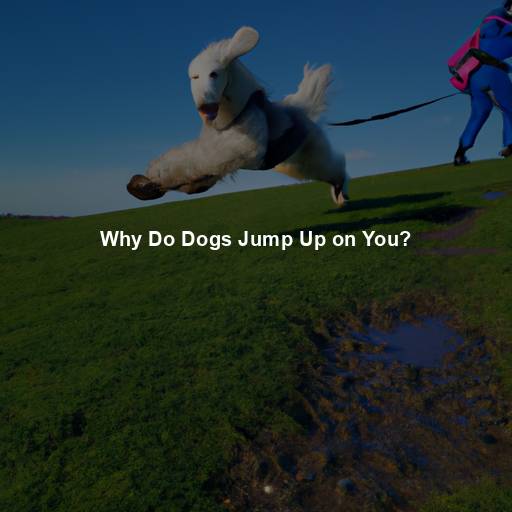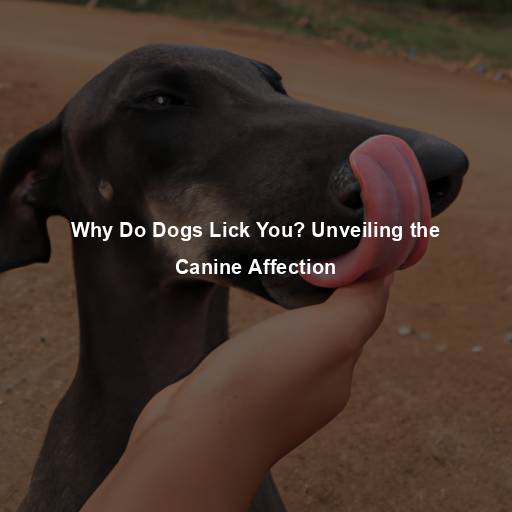Why Do Dogs Jump Up on You?
Last Updated on July 9, 2023 by Evan
Contents [hide]
- 1 Understanding the Behavior of Dogs
- 2 The Potential Issues
- 3 Addressing and Modifying the Behavior
- 4 Understanding Body Language
- 5 Addressing Specific Triggers
- 6 The Role of Positive Reinforcement
- 7 Seeking Professional Assistance
- 8 Managing Jumping Up on Strangers
- 9 Addressing Jumping Up on Family Members
- 10 Additional Tips for Modifying Jumping Up Behavior
- 11 FAQs for why do dogs jump up on you:
- 11.1 Why do dogs jump up on people?
- 11.2 How can I prevent my dog from jumping up on me?
- 11.3 Why is it important to stop a dog from jumping up on me?
- 11.4 Is it normal for puppies to jump up on people?
- 11.5 Can I train my dog to stop jumping up?
- 11.6 Are there any underlying reasons why a dog might jump up excessively?
Understanding the Behavior of Dogs
Dogs are known for their playful and affectionate nature. They often express their excitement by jumping up on people. While this behavior may seem innocent and endearing, it can sometimes be problematic and even dangerous. In this article, we will delve into the reasons why dogs exhibit this behavior and explore effective ways to address and modify it.
The Instinctual Origins
When our furry friends gleefully leap into the air, it’s a fascinating display of their primal instincts at play. In the untamed realm, canines engage in face-to-face sniffing as a way of greeting fellow pack members. By engaging in this upward motion, dogs are essentially trying to embark on a fact-finding mission to gather insights about us. Beyond being an endearing quirk, this behavior serves as a pivotal component of their socialization journey, aiding in the forging of meaningful bonds.
Seeking Attention and Affection
One of the primary reasons why dogs jump up on people is to seek attention and affection. Dogs are highly social animals and thrive on human interaction. By jumping up, they are actively seeking our attention and hoping for a positive response. It is their way of saying, “Hey, I’m here!
Reinforcement and Encouragement
It’s worth considering how inadvertently reinforcing certain behaviors can unexpectedly perpetuate and even amplify them. Take the common scenario of a dog jumping up on people. Even if our response is to scold or physically push them away, they perceive it as attention, which inadvertently rewards their action. This tangled dynamic inadvertently fuels their desire to repeat the behavior, as any form of attention is better than being ignored.
The Potential Issues
While a dog’s jumping up behavior may seem harmless, it can lead to several issues that need to be addressed. Let’s explore some of these concerns:
Safety Concerns
When it comes to the well-being of certain individuals, such as seniors, those with physical vulnerabilities, or parents with young children, the exuberant leaps of a lively canine can become somewhat precarious. The sheer size and enthusiasm of the dog in question can easily destabilize someone, causing an inadvertent tumble or even a full-on collision, leading to an array of potential injuries that simply cannot be overlooked. In such situations, the need to navigate this unexpected hurdle with utmost care and caution becomes a paramount concern.
Reinforcing Bad Habits
Allowing a dog to jump up on you without any boundaries or rules establishes a bad habit. This behavior can extend beyond the family members and onto strangers, which may lead to uncomfortable situations and even legal issues if the dog’s behavior becomes aggressive or intimidating.
Disrupting Social Settings
Picture this: you’re hosting a gathering, and suddenly, like a bolt out of the blue, your four-legged friend leaps up to greet your guests. Uh-oh, talk about a perplexing situation! Not only can this unexpected display be disconcerting for some individuals, but it can also disturb the tranquil atmosphere you had meticulously cultivated. To avoid such instances, it’s crucial to establish an environment that is both serene and under control, ensuring everyone feels at ease.
Addressing and Modifying the Behavior
Addressing and modifying a dog’s jumping up behavior is of utmost importance in creating a serene and secure living space. Thankfully, there are a plethora of strategies available to achieve this goal. By implementing these effective techniques, you can establish a peaceful coexistence with your furry companion while ensuring their safety and well-being.
Consistency and Training
Consistency is key when it comes to modifying any unwanted behavior in dogs. Establishing clear rules and boundaries from an early age is essential. Training your dog to understand and respond to commands such as “sit” or “off” can be highly effective in redirecting their attention and preventing them from jumping up.
Positive Reinforcement
Positive reinforcement is a powerful tool in dog training. Instead of scolding or reprimanding your dog when they jump up, focus on rewarding and praising them for good behavior. By providing treats, verbal praise, or affection when they remain calm and keep all four paws on the ground, you are reinforcing the desired behavior.
Ignoring and Withdrawing Attention
Another effective approach is to ignore the dog when they jump up. By withdrawing attention and turning away from them, you are conveying the message that jumping up will not result in any form of interaction. However, it is important to provide attention and affection when the dog is behaving appropriately, as this reinforces the desired behavior.
Redirecting Energy
It’s no secret that our furry friends can sometimes get a little too carried away with their boundless energy, resulting in those unexpected jumps that catch us off guard. However, fear not, for there are ways to channel their enthusiasm into more positive outlets. By incorporating regular exercise routines and enticing them with interactive toys and training sessions, we can redirect their energy in a way that promotes calmness and curbs their urge to jump. So, let’s help our four-legged companions find their inner Zen, one step – or rather, one paw – at a time.
Seeking Professional Help
When it comes to our furry friends, sometimes it can be quite a head-scratcher to figure out how to tackle certain behavioral quirks. Take jumping up, for example. While some solutions may seem obvious, there are instances where the expertise of a seasoned professional is needed to untangle the complexities behind this behavior. Dog trainers and behaviorists possess the know-how to dive deep into the underlying causes, crafting a customized training plan that will have your pooch jumping for joy in no time.
Importance of Early Socialization
When it comes to a dog’s behavioral quirks, early socialization takes center stage. This crucial stage of development intricately weaves the fabric of a canine’s demeanor, particularly their penchant for leaping onto unsuspecting individuals. It all boils down to one pivotal concept: exposing puppies to a plethora of stimuli, encompassing diverse environments, humans of all stripes, and fellow four-legged companions, at a tender age, lays the foundation for forming delightful and socially acceptable habits. A dog who has been well-socialized, thanks to this immersive exposure, is apt to extend a composed welcome to visitors, eschewing the gravity-defying antics of jumping up in excitement.
Socialization Tips
- Introduce your puppy to different environments, such as parks, streets, and other public places.
- Arrange controlled interactions with a variety of people, including children, adults, and seniors.
Create an atmosphere of joy and excitement during socialization sessions by rewarding participants with delightful treats and showers of heartfelt praise. Embrace the power of positivity as you strive to foster memorable and enriching interactions. Intertwine the threads of delightful surprises and sincere words of admiration to enhance the experience and bring smiles to the faces of all involved.
Understanding Body Language
Recognizing Excitement
Dogs often jump up when they are excited or excessively stimulated. Understanding their body language can help us anticipate and address this behavior effectively. Look for signs of excitement, such as wagging tail, raised ears, and a forward-leaning posture. By recognizing these cues, we can intervene and redirect their energy before they jump up.
Calming Signals
Dogs also communicate through calming signals, which are subtle ways of indicating their desire for a peaceful interaction. These signals include yawning, lip licking, and turning their head away. By responding to these signals and providing a calm and controlled environment, we can help dogs feel more at ease and reduce their inclination to jump up.
Addressing Specific Triggers
Greeting Visitors
Creating a harmonious atmosphere when welcoming guests is of utmost importance, and that includes ensuring your furry companion adheres to proper etiquette. By teaching your dog to adopt a composed stance, such as sitting or staying, rather than leaping in enthusiastic abandon, you can establish a more tranquil environment. To further reinforce these desirable behaviors, reward your fluffy friend with delectable treats and heartfelt praise, leaving them imbued with a sense of poise and serenity.
Handling Overexcitement
Some dogs may become particularly excited during playtime or when engaging in certain activities. If your dog tends to jump up during these moments, it’s important to redirect their energy. Use interactive toys, such as puzzle feeders or treat-dispensing toys, to keep them mentally stimulated and engaged. Additionally, engage in regular exercise to help them burn off excess energy and reduce the likelihood of jumping up.
The Role of Positive Reinforcement
Consistency in Training
When it comes to transforming a dog’s behavior, maintaining consistency is the key. It’s essential for everyone involved, be it family members or anyone who interacts with the furry friend, to be on the same wavelength and adhere to the established rules and guidelines. Taking a haphazard approach to dealing with jumping up can leave the poor pup perplexed and impede any progress made in reshaping their behavior. So, let’s strive for consistency and give our fur babies the clarity they need.
Rewarding Desired Behavior
Positive reinforcement involves rewarding the desired behavior to encourage its repetition. Whenever your dog remains calm and keeps all four paws on the ground, offer verbal praise, treats, or affection as a reward. This positive association reinforces the idea that staying down is the desired behavior, making them more likely to repeat it in the future.
Avoiding Punishment
When it comes to curbing jumping up behavior in dogs, we must tread carefully. The notion of resorting to punishment-based techniques may have crossed your mind, but it’s crucial to understand the potential consequences. Approaches that involve physical punishments or scolding can inadvertently sow the seeds of fear and anxiety in our furry friends, ultimately exacerbating other behavioral problems. To achieve lasting results, it’s wise to concentrate on the power of positive reinforcement and the art of redirection.
Seeking Professional Assistance
Addressing the issue of a dog’s persistent jumping up behavior can be a perplexing task, despite consistent training and positive reinforcement. In some cases, seeking professional assistance from a dog trainer or behaviorist becomes necessary to unravel the complexity of the situation and gain valuable insights. Their tailored guidance can unveil a unique approach to tackle this burst of energy in your furry friend.
Breed-Specific Tendencies
When it comes to the boundless world of dog behavior, jumping up is a perplexing puzzle that can baffle even the most seasoned pet owner. Every dog breed, it seems, brings its own unique burst of energy to the table, making this acrobatic act as diverse as the canine kingdom itself. Take, for instance, the Labrador Retrievers and Golden Retrievers, known for their unwavering enthusiasm. These exuberant breeds may be especially prone to the gravity-defying feat of jumping up.
Size Considerations
The size of a dog can also influence the impact of their jumping up behavior. While a small dog’s jump may not pose a significant safety concern, a larger dog’s jump can be more intimidating and potentially cause harm. It is important to address and modify jumping up behavior in all dogs, regardless of their size, to ensure a safe and enjoyable interaction with both family members and strangers.
Managing Jumping Up on Strangers
Teaching Alternative Greetings
It’s no secret that dogs can sometimes get a little too enthusiastic when meeting new people, often resulting in an unwanted display of jumping up. However, there is a solution! By teaching your furry friend an alternative, more polite way to greet strangers, you can redirect their behavior and avoid those embarrassing moments. Instead of jumping up, train them to sit or offer a paw as a friendly greeting.
Controlled Encounters
When encountering strangers during walks or in public spaces, it is important to have control over your dog’s behavior. Keep them on a leash and practice commands such as “sit” or “stay” to maintain their focus and prevent them from jumping up on passersby. Consistent training and positive reinforcement will help them understand the appropriate behavior in different social settings.
Addressing Jumping Up on Family Members
Consistency within the Household
Consistency is key when addressing jumping up behavior within the family. Ensure that all family members follow the established rules and guidelines consistently. If one family member allows the dog to jump up while others discourage it, confusion can arise, making it challenging to modify the behavior effectively.
Establishing Boundaries
Setting clear boundaries with your dog is important to manage jumping up behavior. Teach them that jumping up is not acceptable by consistently redirecting their attention to an alternative behavior, such as sitting or staying. Use positive reinforcement to reward and reinforce these desired behaviors, gradually reducing the instances of jumping up.
Additional Tips for Modifying Jumping Up Behavior
Patience and Persistence
Modifying a dog’s jumping up behavior requires patience and persistence. It is important to remember that changes in behavior take time, and progress may occur gradually. Celebrate small victories and continue to reinforce positive behavior while consistently redirecting and discouraging jumping up.
Seeking Support from the Community
Joining a community of dog owners or seeking advice from experienced trainers can provide valuable support and guidance. Connecting with others who have experienced similar challenges can offer insights, tips, and encouragement throughout the process of modifying jumping up behavior.
FAQs for why do dogs jump up on you:
Why do dogs jump up on people?
When it comes to our furry companions, dogs have an intriguing way of expressing their overflowing enthusiasm: jumping up on people. This natural behavior, deeply rooted in their doggie DNA, showcases their happiness and eagerness to engage with others. Leaping towards someone’s face, they joyfully utter their greetings. Yet, as with any canine characteristic, this gesture can occasionally stem from a desire for attention or even an attempt to assert dominance – particularly in the case of pooches lacking proper training or socialization.
How can I prevent my dog from jumping up on me?
To prevent your dog from jumping up on you, it is important to first not encourage the behavior. Avoid rewarding or reinforcing jumping by not giving attention or affection to your dog when they jump up. Instead, teach them an alternative behavior such as sitting or staying calm when greeting people. Consistent training, positive reinforcement, and redirecting their attention to appropriate activities can help discourage jumping up.
Why is it important to stop a dog from jumping up on me?
Allowing a dog to continue jumping up on people can be problematic for several reasons. Firstly, it can be uncomfortable or intimidating for some individuals, particularly children or elderly people who may have difficulty maintaining balance. Additionally, jumping up with muddy paws or sharp nails can cause physical harm or damage to clothing. It is also crucial to prevent this behavior to establish a well-behaved and obedient dog, as jumping up can be seen as rude or unruly in certain social settings.
Is it normal for puppies to jump up on people?
It’s not surprising that puppies have a tendency to leap up on people with their boundless energy and curiosity. Their inherent desire to explore and engage with humans often leads them to take this approach. However, it’s crucial to tackle this behavior head-on and establish a consistent training regimen to instill good manners in our furry companions. By offering firm guidance and positive reinforcement, we can empower our puppies to develop more controlled and respectful ways of greeting others as they mature.
Can I train my dog to stop jumping up?
Absolutely! Training your dog to stop jumping up is possible with patience and positive reinforcement. Consistency is key in teaching your dog an alternative behavior such as sitting or staying calm when meeting people. Utilizing rewards, such as treats or praise, when your dog displays the desired behavior will help reinforce their understanding of what is expected from them. Seek guidance from a professional dog trainer if needed, as they can provide effective techniques and advice tailored to your specific dog’s needs.
Are there any underlying reasons why a dog might jump up excessively?
Yes, in some cases, excessive jumping up can be a sign of underlying issues such as anxiety, fear, or overexcitement. It is important to observe your dog’s behavior and consult with a veterinarian if you suspect any underlying problems contributing to the excessive jumping. They can help determine if there are any medical or behavioral reasons behind the behavior and provide guidance on how to address them effectively.







